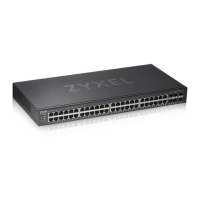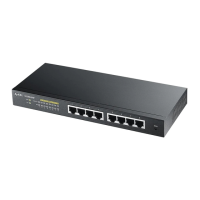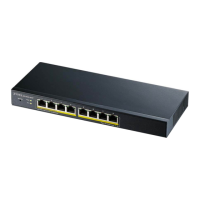Chapter 58 Classifier
GS1920v2 Series User’s Guide
370
Time
Range
Select the name of the pre-configured schedule that you want to apply to the rule. The rule will be
active only at the scheduled date and/or time.
If you select None, the rule will be active all the time.
Ingress Port
Port Select Any to apply the rule to all ports.
Alternatively, to specify the ports enter the port numbers to which the rule should be applied. You can
enter multiple ports separated by (no space) comma (,) or hyphen (-). For example, enter “3-5” for
ports 3, 4, and 5. Enter “3,5,7” for ports 3, 5, and 7.
Trunk Select Any to apply the rule to all trunk groups.
Alternatively, to specify multiple trunks, enter the trunk group ID to apply the rule to multiple trunks.
You can enter multiple trunks with (t) or (T) then the trunk group ID separated by (no space) comma
(,) or hyphen (-). For example, enter “t3-t5” for trunks 3, 4, and 5. Enter “T3,T5,T7” for trunks 3, 5, and 7.
Layer 2
Specify the fields below to configure a layer 2 classifier.
VLAN Select Any to classify traffic from any VLAN or select the second option and specify the source VLAN
ID in the field provided.
Priority Select Any to classify traffic from any priority level or select the second option and specify a priority
level in the field provided.
Ethernet
Type
Select an Ethernet type or select Other and enter the Ethernet type number in hexadecimal value.
Source
MAC
Address
Select Any to apply the rule to all MAC addresses.
To specify a source, select MAC/Mask to enter the source MAC address of the packet in valid MAC
address format (six hexadecimal character pairs) and type the mask for the specified MAC address to
determine which bits a packet’s MAC address should match.
Enter “f” for each bit of the specified MAC address that the traffic’s MAC address should match. Enter
“0” for the bits of the matched traffic’s MAC address, which can be of any hexadecimal characters.
For example, if you set the MAC address to 00:13:49:00:00:00 and the mask to ff:ff:ff:00:00:00, a packet
with a MAC address of 00:13:49:12:34:56 matches this criteria. If you leave the Mask field blank, the
Switch automatically sets the mask to ff:ff:ff:ff:ff:ff.
Destinatio
n MAC
Address
Select Any to apply the rule to all MAC addresses.
To specify a destination, select MAC/Mask to enter the destination MAC address of the packet in
valid MAC address format (six hexadecimal character pairs) and type the mask for the specified MAC
address to determine which bits a packet’s MAC address should match.
Enter “f” for each bit of the specified MAC address that the traffic’s MAC address should match. Enter
“0” for the bits of the matched traffic’s MAC address, which can be of any hexadecimal characters.
For example, if you set the MAC address to 00:13:49:00:00:00 and the mask to ff:ff:ff:00:00:00, a packet
with a MAC address of 00:13:49:12:34:56 matches this criteria. If you leave the Mask field blank, the
Switch automatically sets the mask to ff:ff:ff:ff:ff:ff.
Layer 3
Specify the fields below to configure a layer 3 classifier.
IPv4/IPv6
DSCP
Select Any to classify traffic from any DSCP or select the second option and specify a DSCP (DiffServ
Code Point) number between 0 and 63 in the field provided.
Preceden
ce
Select Any to classify traffic from any precedence or select the second option and specify an IP
Precedence (the first 3 bits of the 8-bit ToS field) value between 0 and 7 in the field provided.
ToS Select Any to classify traffic from any ToS or select the second option and specify Type of Service (the
last 5 bits of the 8-bit ToS field) value between 0 and 255 in the field provided.
Table 208 SECURITY > ACL > Classifier > Classifier Setup > Add/Edit (continued)
LABEL DESCRIPTION

